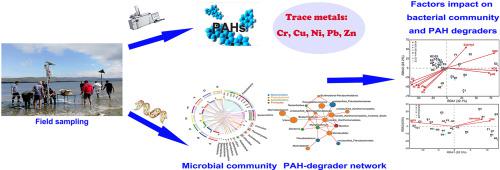Environmental Pollution ( IF 7.6 ) Pub Date : 2020-11-26 , DOI: 10.1016/j.envpol.2020.116083 Xinran Liu , Min Liu , Limin Zhou , Lijun Hou , Yi Yang , Dianming Wu , Michael E. Meadows , Zhanhai Li , Chunfu Tong , Jinghua Gu

|
This study investigated the polycyclic aromatic hydrocarbons (PAHs) occurrence, and their impact on the microbial community and PAH-degrading genera and genes in the Knysna Estuary of South Africa. The results reveal that the estuary exhibits low PAH levels (114.1 to 356.0 ng g-1). Ignavibacteriae and Deferribacteres, as well as Proteobacteria and Bacteroidetes, are keystone phyla. Among measured environmental factors, total organic carbon (TOC), nutrients such as nitrite and nitrate, metals as Al, Cr, Cu, Ni, Pb and Zn, and environmental properties (pH and salinity) are primary contributors to structuring the bacterial community assemblage. The abundance of alpha subunit genes of the PAH-ring hydroxylating dioxygenases (PAH-RHDα) of Gram-negative bacteria lies in the range of (2.0 to 4.2)×105 copies g-1, while that of Gram-positive bacteria ranges from 3.0×105 to 1.3×107 copies g-1. The PAH-degrading bacteria account for up to 0.1% of the bacterial community and respond mainly to nitrate, TOC and salinity, while PAHs at low concentration are not significant influencing factors. PAH degraders such as Xanthomonadales, Pseudomonas, and Mycobacterium, which play a central role in PAH-metabolization coupled with other biogeochemical processes (e.g. iron cycling), may contribute to maintaining a healthy estuarine ecosystem. These results are important for developing appropriate utilization and protection strategies for pristine estuaries worldwide.
中文翻译:

南非克尼斯纳河口近岸沉积物中多环芳烃和微生物群落的分布
这项研究调查了多环芳烃(PAHs)的产生,及其对南非克尼斯纳河口微生物群落和PAH降解属和基因的影响。结果表明,河口的PAH水平较低(114.1至356.0 ng g -1)。灼热细菌和去铁细菌以及变形杆菌和拟杆菌属是基石门。在测量的环境因素中,总有机碳(TOC),营养物质(例如亚硝酸盐和硝酸盐),金属(例如Al,Cr,Cu,Ni,Pb和Zn)以及环境特性(pH和盐度)是构成细菌群落结构的主要因素。 。革兰氏阴性细菌的PAH环羟化双加氧酶(PAH-RHDα)的α亚基基因的丰度在(2.0到4.2)×10 5的范围内革兰氏阳性细菌的拷贝数为g -1,而革兰氏阳性细菌的拷贝数为3.0×10 5到1.3×10 7拷贝g -1。降解PAH的细菌占细菌总数的0.1%,并且主要对硝酸盐,TOC和盐度有响应,而低浓度的PAH并不是重要的影响因素。PAH降解物,如Xanthomonadales,Pseudomonas和分枝杆菌,在PAH代谢以及其他生物地球化学过程(例如铁循环)中起着核心作用,可能有助于维持健康的河口生态系统。这些结果对于为全球原始河口制定适当的利用和保护策略非常重要。











































 京公网安备 11010802027423号
京公网安备 11010802027423号